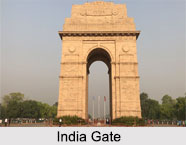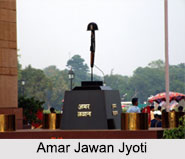 Established in the year 1921, the India Gate is located at the heart of India"s capital city, New Delhi. About 2.3 km from the Rashtrapati Bhavan, it is situated on the eastern end of the ceremonial boulevard, Rajpath. It was built by an Englishman named Sir Edwin Lutyens, who was also the principal planner of New Delhi. The India Gate was one of many British monuments built by the order of the Imperial War Graves Commission, which was later renamed as Commonwealth War Graves Commission. Officially known as the Delhi Memorial, the India Gate was unveiled in the year 1931 by Viceroy Lord Irwin, during which time it was also the formal dedication of New Delhi as the capital city of India.
Established in the year 1921, the India Gate is located at the heart of India"s capital city, New Delhi. About 2.3 km from the Rashtrapati Bhavan, it is situated on the eastern end of the ceremonial boulevard, Rajpath. It was built by an Englishman named Sir Edwin Lutyens, who was also the principal planner of New Delhi. The India Gate was one of many British monuments built by the order of the Imperial War Graves Commission, which was later renamed as Commonwealth War Graves Commission. Officially known as the Delhi Memorial, the India Gate was unveiled in the year 1931 by Viceroy Lord Irwin, during which time it was also the formal dedication of New Delhi as the capital city of India.
History of the India Gate
India Gate is a war memorial, which means that it was built to pay tribute to those who died in the First World War and the other wars that followed thereafter, like the Third Anglo-Afghan War. In the year 1921, the foundation stone of India Gate was laid by the Duke of Connaught in a military ceremony attended by members of the Indian Army as well as the Imperial Service Troops.
Every year on 26th January, the Republic Day parade starts from the Rashtrapati Bhavan and passes around the Gate. The parade displays the latest achievements in the fields of defense, technology as well as the rich cultural heritage of the country.
 Architecture of the India Gate
Architecture of the India Gate
The India Gate stands at a height of 42 metres on a low base of red and yellow sandstones from Bharatpur and rises in asymmetrical steps crowned with a shallow dome at the top. The Gate evokes the architectural style of the triumphal arch, similar to the Arc de Triomphe in Paris and the Gateway of India in Mumbai. There is also a vacant canopy in front of the monument under which once stood the statue of George V in his coronation robes, Imperial State Crown, British globus cruciger and sceptre. The statue was later shifted to Coronation Park in 1960 and the empty canopy symbolizes the British retreat from India.
Situated below the India Gate is another memorial that was added much later after the independence of India is the Amar Jawan Jyoti. Also known as the flame of the immortal soldier, it is a structure consisting of a black marble plinth. It was built to commemorate the Indian soldiers who gave their life in the defence of their country in the Bangladesh Liberation War of 1971. The four eternal flame burns day and night under the arch in the memory of these soldiers.
Inscriptions on the India Gate
The cornices of India Gate are adorned with the inscription of sun which symbolized the British Imperial Colony. The word INDIA is inscribed at the top of the arches on both sides flanked by the dates MCMXIV (1914) on the left and MCMXIX (1919) on the right. Below this the following passage is inscribed: To the dead of the Indian armies who fell and are honoured, in France and Flanders, Mesopotamia and Persia, East Africa, Gallipoli and elsewhere in the Near and the Far East and in sacred memory also of those whose names are here recorded and who fell in India on the north-west frontier and during the Third Afghan War.
Visiting Information on the India Gate
The India Gate monument is nearest to the Central Secretariat Metro Station in Delhi. Open all days of the week, the Gate is illuminated every evening from 7 pm to 9:30 pm and is a major tourist attraction.